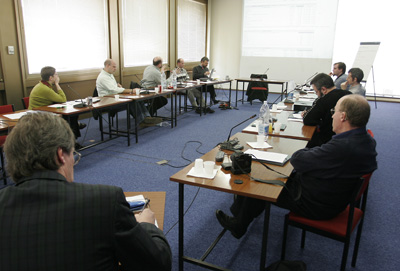
 |
jescom | profiles | documents | links | sjweb |

Webmasters of the European Jesuit provinces met at the Curia Generalizia in Rome from March 16-19, 2006 for their second meeting. They spent a significant amount of time reviewing changes in the province web sites over the last year and saw a noticeable jump in quality. It is also noteworthy that half of the sites (Austria, Croatia, Germany, Ireland, Poland, Spain, Sovakia, Tarragon, Slovenia) now have some kind of apostolic content related to spirituality that is oriented towards the needs of visitors rather than information about the Society of Jesus itself.
Austria took the biggest step in its internet by creating an online spirituality course, but many others are doing something similar. Austria has offered two online "courses" which are a kind of retreat. People have to subscribe to the course and the number of places is limited to 300 persons. Participants each have a password to enter. There is a lot of written material to read and pray over. Once a week there is an hour-and-a-half long online chat. Neulinger said that the format proved to be "simple yet efficient." People can also post reflections for others to read. They drew people primarily from Austria, Switzerland and Germany, but also from Latin America Users tended to be people without a church affiliation. Most were professional peopleSpain has a separate site for youth that has some information about the people (ie: the Jesuits) who created the site, but who are not the focus of it.
Perhaps the liveliest discussion came in a session led by Fr. Peter Scally of Great Britain about using the web for pastoral purposes. Peter Scally began the session with the question, "Why is the web a good place for spirituality?"
Answers included its accessibility. It is easier visiting a web site than going into a bookstore or a retreat center. A web site also costs less to use than a residential retreat center. Privacy and confidentiality are also factors. In secularized societies like Britain, people can sample spirituality and religion in the privacy of their homes. They find that they like it and are free to pursue it further, but they don't have to make a public statement by investigating it publicly. There is more rich media content on the web, and users can make choices and the user experience can be tailored to individual preferences. This fits in more with Ignatian spirituality than with some other approaches. Furthermore, a web site can keep its material fresh and up to date. People like the sense of being part of a world-wide community, of being connected. Finally, sitting in front of a computer is actually a good place to pray. You usually have a comfortable chair.
From the Jesuit point of view, the web gives us an incredible reach to millions of viewers. It is low cost and does not require much staff. (ie: Sacred Space reaches 15,000 people per day with only two full-time people working at it.) Furthermore, "Jesuit" as a brand has a strong element of trust, people know us and trust our authority in prayer. There is a general sense that "these are people who know what they are talking about in prayer."
We looked at the question whether spirituality practised through the web tends towards increased isolation? The evidence suggests that it moves people towards community. Other questions that were discussed included the following: What is the ecclesial status of virtual community? Could there be a danger in seeing this as an alternative to the Church rather than as an aid to it. How do we get them to take that next step and move deeper in spirituality? Is it effective and possible to do spiritual direction by email? (Ignatius did some by hand-written correspondence). At the end the group faced the question: how do we cater to individuals without leading to individualism?
A number of sessions focused on concrete ways to improve websites. Two professional designers from Gruppo Pragma, an Italian web production company, addressed the question and presented many practical ways to increase quality. Among other points they recommended decreasing the number of clicks necessary to arrive at desired content, search engines (so people can find information without having to burrow through lots of pages), clear navigation (people know where they are and kind easily move to where they want to be, and fast loading time (at maximum 10 sec, but more like 2 or 3). They emphasized starting with the user. The more you know about the user, the more effective your site will be. One goal should be to get users to become involved, give them a way to participate in the site and become "senders" of messages as well as users of what is provided. They defined "quality" as a user being able to do all the desired operations easily and quickly without being frustrated. Quality also means the user trusts the web site and the people behind it.
Members of the group also gave presentations. Fr. Thomas Neulinger and Fr. Albert Bacar talked about how to make use of web statistics. Fr. Tiziano Repetto discussed the merits of a dynamic, database-driven web site while Fr. Tom Rochford gave a presentation on how to take better photographs.